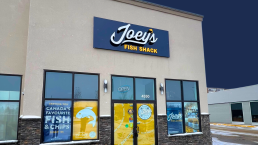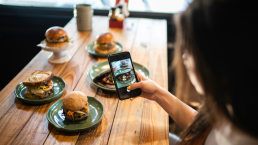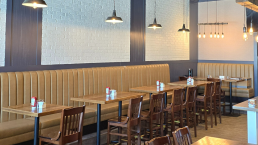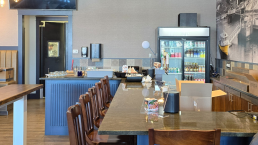3 Essential Marketing Strategies: Nail the Basics
In today’s competitive restaurant industry, effective marketing strategies are essential to stand out and attract customers. As a restaurant owner, you’re constantly seeking ways to fill your seats and boost your revenue. In this article, we’ll explore three essential marketing strategies that your restaurant needs to start implementing right away.
-
Organic Posts: Engage Your Audience Without Breaking the Bank
Organic posts are a cost-effective way to connect with your audience on social media platforms like Instagram and Facebook. These posts include pictures of your food, videos, stories, and live streams. They provide an authentic glimpse into your restaurant’s atmosphere and offerings, fostering engagement and building a loyal following.
However, with the ever-increasing competition on social media, organic reach has declined. That’s where paid advertising comes in.
- Keep it authentic: Share behind-the-scenes glimpses of your restaurant, staff, and kitchen to humanize your brand and connect with your audience on a personal level.
- Use user-generated content: Encourage customers to share their dining experiences by tagging your restaurant and reshare their content with your audience, fostering community and social proof.
- Leverage hashtags: Research relevant hashtags in your industry and location to increase the discoverability of your posts and attract new followers.
-
Paid Advertising: Boost Your Visibility and Reach New Customers
Paid advertising allows you to amplify your organic posts and reach a larger audience. Platforms like Facebook offer targeted advertising options, allowing you to tailor your ads to specific demographics, interests, and behaviors.
By investing in paid advertising, you can ensure that your content gets seen by more people, increasing brand awareness and driving traffic to your restaurant. Whether it’s promoting daily specials, upcoming events, or seasonal promotions, paid advertising is a powerful tool in your marketing arsenal.
- Set clear objectives: Define your advertising goals, whether it’s increasing website traffic, generating leads, or driving sales, and tailor your ad campaigns accordingly.
- Test and optimize: Experiment with different ad formats, targeting options, and creatives to identify what resonates best with your audience, and optimize your campaigns based on performance metrics.
- Monitor your budget: Keep a close eye on your advertising budget to ensure you’re getting the most bang for your buck, adjusting your spending as needed to maximize ROI.
-
Building a Database: Establishing Long-Term Relationships with Customers
While social media is a valuable marketing tool, it’s essential to move beyond it and establish direct communication channels with your customers. Building a database of customer contacts, including names, email addresses, and phone numbers, allows you to nurture relationships and drive repeat business.
- Offering irresistible incentives, such as exclusive discounts or special offers, encourages customers to join your database. Once you’ve captured their contact information, you can communicate with them directly via email or text messages, keeping them informed about upcoming promotions, events, and new menu items.
- Offer value: Provide exclusive perks, such as VIP discounts, birthday treats, or members-only events, to incentivize customers to join your database and stay engaged.
- Segment your list: Divide your database into distinct segments based on factors like purchase history, preferences, or frequency of visits, allowing you to tailor your communications and offers to each group.
- Respect privacy and preferences: Be transparent about how you’ll use their contact information, and give customers control over their communication preferences, including the frequency and type of messages they receive.
Conclusion:
In today’s digital age, effective marketing is the key to success for restaurants. By implementing organic posts, paid advertising, and building a database of loyal customers, you can create a powerful marketing strategy that drives traffic to your restaurant and keeps customers coming back for more.
Remember, consistency is key. By consistently engaging with your audience through organic posts, investing in targeted advertising, and nurturing relationships with your database, you can maximize your restaurant’s visibility and profitability.
Maximizing Restaurant Revenue on Slow Days: 7 Proven Strategies
In the competitive world of the restaurant business, slow days can be a significant challenge. However, savvy restaurateurs understand that with the right strategies, these quiet periods can be transformed into profitable opportunities. Drawing from real-world examples and data-backed insights, let’s explore seven effective tactics to boost restaurant sales on traditionally sluggish days.
1. Promote Direct Catering Business
Catering isn’t just a supplementary revenue stream; it’s a lucrative opportunity to capitalize on slow days. By targeting corporate clientele, particularly on Mondays and Tuesdays, restaurants can tap into a market hungry for catering services. Unlike relying on third-party platforms, promoting direct catering ensures higher profitability and greater control over customer relationships.
2. Implement Slow Day Specials
Create irresistible offers tailored to slow days, such as Taco Tuesdays or Wine Wednesdays. These specials not only incentivize customers to visit but also showcase popular menu items with attractive discounts. Leveraging social media, email marketing, and in-store promotions, restaurants can effectively spread the word and drive traffic on off-peak days.
3. Utilize Email Automation
Harness the power of email automation to keep customers informed about special promotions and events. By scheduling targeted emails, such as Taco Tuesday reminders, restaurants can engage customers at the right time without the hassle of manual outreach. Personalized messages highlighting exclusive deals encourage repeat visits and foster customer loyalty.
4. Leverage App Push Notifications
Extend promotional reach with app push notifications, boasting impressive engagement rates compared to traditional email campaigns. With timely reminders and enticing offers, restaurants can capture the attention of app users and drive immediate action. Integration with online ordering systems further streamlines the purchasing process, enhancing convenience for customers.
5. Execute Text Message Blasting
Directly reach opted-in customers through text message blasts, delivering timely promotions and exclusive offers. By leveraging customer data and targeting specific segments, restaurants can generate excitement and drive online orders. Incorporating limited-time incentives, such as free delivery, entices recipients to act quickly, resulting in increased sales.
6. Host Live Music Nights
Transform slow evenings into vibrant social experiences with live music events. Collaborating with local musicians not only enhances the ambiance but also attracts passersby intrigued by the lively atmosphere. Social media promotion and targeted emails help spread awareness, enticing patrons to dine out and enjoy the entertainment.
7. Organize Game Nights
Engage the community with interactive game nights, offering a unique dining experience beyond traditional meals. From Bingo to trivia, themed game nights create a sense of camaraderie and foster connections among guests. Utilizing social media platforms and email automation, restaurants can promote these events and draw in crowds on slower days.
Incorporating these strategies into your restaurant’s marketing playbook can significantly impact revenue generation on slow days. By leveraging technology, creativity, and targeted promotions, establishments can turn downtime into bustling business opportunities, ultimately driving growth and success in the competitive restaurant industry.
Maximizing Restaurant Success: The Strategic Importance of Loyalty Programs
In the dynamic landscape of the restaurant industry, staying ahead requires more than just serving great food. It demands building lasting relationships with customers, and one of the most effective ways to achieve this is through a well-designed loyalty program. In this article, we delve into the critical role of loyalty programs for restaurants and how they can be leveraged to enhance brand value while fostering customer loyalty.
Why Is a Loyalty Program Important?
In a crowded market, where customers have countless options, loyalty programs serve as a powerful tool to differentiate your restaurant from competitors. By offering incentives such as discounts, exclusive offers, or rewards points, you not only encourage repeat visits but also create a sense of belonging and appreciation among patrons. This emotional connection can significantly impact customer retention and brand advocacy, driving long-term success.
How to Use a Loyalty Program Without Devaluing Your Brand
Maintaining brand integrity while implementing a loyalty program is crucial. To avoid devaluation, focus on creating a program that aligns with your brand’s identity and values. Offer rewards that enhance the customer experience rather than cheapening it. For instance, prioritize personalized rewards based on customer preferences and behavior, ensuring each interaction feels genuine and meaningful. Additionally, emphasize the exclusivity of your program, making members feel like part of an elite community with access to unique benefits.
Extending the Lifetime Value of Customers
A well-executed loyalty program goes beyond immediate transactions; it’s about nurturing long-term relationships. By consistently rewarding loyalty, you not only retain existing customers but also increase their lifetime value. Encourage repeat visits and higher spending through tiered rewards systems or milestone incentives. Moreover, leverage data analytics to gain insights into customer behavior, enabling you to tailor offerings and communication to individual preferences, thus further enhancing loyalty and lifetime value.
A More Consistent Inflow of Customers
Loyalty programs serve as a powerful driver for consistent customer traffic. By incentivizing return visits and encouraging word-of-mouth referrals, you create a steady stream of business that stabilizes revenue and minimizes the impact of seasonal fluctuations or market disruptions. Moreover, with the rise of digital loyalty programs, you can leverage mobile apps and online platforms to engage with customers proactively, sending targeted promotions and reminders to keep your restaurant top-of-mind.
Why Single-Time Offers Are Ineffective Without Continuous Outreach
While one-time promotions may attract initial interest, they often fail to foster long-term loyalty. Without a structured loyalty program in place, customers may view these offers as transactional rather than relational, resulting in limited engagement beyond the initial interaction. In contrast, a loyalty program provides ongoing incentives for customers to return, allowing you to nurture relationships over time and drive sustained revenue growth.
In conclusion, loyalty programs are essential for restaurants seeking to thrive in today’s competitive market. By prioritizing customer retention, brand integrity, and long-term value creation, restaurants can leverage loyalty programs to foster meaningful connections with patrons, drive consistent business, and secure a sustainable future of success.
Mastering Content Creation for Your Restaurant
In today’s digital landscape, content creation plays a pivotal role in engaging customers and building a loyal following for your brand. But what exactly is content creation, and why is it so crucial? Let’s delve into these questions and explore the diverse types of content that can elevate your brand’s presence in the market.
Understanding Content Creation:
Content creation is the art of crafting engaging material that resonates with your target audience. It’s about more than just pushing out information – it’s about creating a connection with your customers, keeping them informed, entertained, and ultimately, loyal to your brand. Creating content isn’t just about filling space on your social media feed; it’s about making your customers feel like they’re part of something bigger – your journey, your tribe. When customers feel connected to your brand, they’re more likely to support you, even if it means paying a premium for your products or services.
The Eight Types of Content You Should Be Creating:
- Business and Brand: Introduce your brand to new customers by sharing your story, values, and milestones. Keep your audience informed about important updates, such as business hours and closures.
- Products: Showcase your products through photos and videos, giving customers a glimpse of what you offer. Utilize features like photo tagging to make purchasing seamless for your audience.
- Lifestyle: Show your products in action, incorporating a human element to humanize your brand and make it relatable to your audience.
- Testimonials and Product Reviews: Share feedback from satisfied customers to build trust and credibility in your brand. User-generated content adds authenticity to your marketing efforts.
- Behind the Scenes: Offer a behind-the-scenes look at your business operations, showcasing the people and processes behind your products.
- User-Generated Content: Leverage content created by your customers to showcase real-life experiences with your brand. Always ask for permission before reposting user-generated content.
- Themed Timely Content: Capitalize on holidays and special events to create themed content that resonates with your audience. This type of content keeps your brand relevant and engaging.
- Promotions and Campaigns: Drive sales and engagement with promotions, discounts, and branded campaigns. Remember to strike a balance between promotional content and value-driven content.
Tips for Effective Content Creation:
– Use your authentic voice to connect with your audience on a personal level.
– Always include a call to action to encourage engagement and action from your audience.
– Be patient and consistent in your content creation efforts, knowing that building a loyal community takes time.
Conclusion:
Mastering content creation is essential for building a strong brand presence and connecting with your audience on a deeper level. By diversifying your content and staying authentic to your brand values, you can create meaningful experiences that resonate with your customers and drive long-term loyalty.
Optimizing Your Instagram Profile: A Guide for Restaurants
Your Instagram profile is your digital storefront, offering potential customers a glimpse into who you are, what you offer, and how they can engage with your brand. In today’s fast-paced digital world, making a strong first impression is crucial. In this article, we’ll delve into the essential elements of an effective Instagram profile and how to optimize them for maximum visibility and engagement.
1. The Importance of Your Instagram Bio:
Your Instagram bio serves as the gateway to your brand. In just a few seconds, visitors should grasp key details about your business and what sets you apart. With attention spans shorter than ever, clarity and conciseness are paramount to keeping users engaged.
2. The Five Essentials for Your Instagram Profile:
We’ll break down the five essential components of your Instagram profile: name, category, location, website link, and bio description. Each element plays a vital role in conveying your brand identity and facilitating user engagement.
3. Your Username:
Your name should not only include your brand name but also a relevant keyword that describes what you offer. This strategic use of keywords enhances your discoverability and ensures that potential customers can easily find you.
4. Select a Category:
Selecting the appropriate category for your business helps users understand the type of products or services you provide. Don’t overlook this section, as it provides valuable context for visitors.
5. Share your Location:
Including your location helps establish a sense of trust and locality with your audience. Be sure to include your city and province/state to make it easier for potential customers to connect with you.
6. Website Link:
Utilize the website link section to direct users to your online storefront or order form. This is a prime opportunity to drive traffic and conversions, so don’t let it go to waste.
7. Bio Description:
With only 150 characters, your bio description must succinctly convey what makes your brand special, provide avenues for engagement (such as branded hashtags), highlight availability for inquiries, and prompt users to take action.
8. Crafting Compelling Bio Descriptions:
We’ll explore strategies for crafting compelling bio descriptions that address four key questions: What makes your product/service special? How can customers engage with you? When are you available for inquiries? How can customers place an order?
9. Using Branded Hashtags:
Branded hashtags offer a unique way to categorize and showcase your brand on Instagram. Encourage users to tag your brand in their posts using a consistent hashtag, boosting your visibility and credibility over time.
10. The Power of Emojis:
Emojis add flair and personality to your bio, making it more visually appealing and engaging. Incorporate emojis strategically to enhance readability and convey tone.
11. Formatting and Legibility:
Ensure your bio is well-formatted and legible to enhance user experience. A clear and structured layout makes it easier for visitors to digest information quickly.
Conclusion:
Optimizing your Instagram profile is essential for capturing the attention of potential customers and driving engagement. By following the strategies outlined in this article, you can create a compelling profile that effectively communicates your brand’s identity and encourages user interaction. Take the time to personalize your profile and make it stand out in a crowded digital landscape.
Mastering Order Fulfillment: A Comprehensive Guide
In the realm of running a successful food business online, mastering order fulfillment is paramount. Whether you’re offering pickup options or doorstep delivery, ensuring a seamless process not only fosters customer satisfaction but also builds trust and loyalty. Let’s delve into the intricacies of order fulfillment and explore the strategies to optimize this vital aspect of your business.
The Importance of Order Fulfillment
Order fulfillment is not just about delivering products; it’s about crafting exceptional experiences for your customers. By prioritizing efficient order fulfillment, you bolster your reputation and instill confidence in your brand. Trust, after all, is the cornerstone of customer loyalty in the online food industry.
Components of Effective Order Fulfillment
- Setting Expectations: Clearly communicate pickup or delivery timelines to customers, ensuring they know when to expect their orders. Setting strict but reasonable time frames minimizes confusion and enhances customer satisfaction.
- Convenience: Simplify the ordering process by making pickup and delivery options straightforward and hassle-free. Customers appreciate businesses that prioritize convenience, leading to repeat purchases and positive reviews.
- Time Management: Efficient time management is essential, especially for those balancing multiple responsibilities. Establishing a well-defined order fulfillment process enables you to effectively allocate your time and resources, maximizing productivity.
Pickup: The Art of Convenience
For businesses offering pickup options, meticulous planning is key. Ensure prompt communication with customers regarding order readiness and establish fixed pickup times. By adhering to a strict schedule, you not only streamline operations but also cultivate a reputation for reliability.
Delivery: Navigating the Options
When it comes to delivery, businesses have two primary options: personal delivery or third-party services. While personal delivery offers greater control and potentially lower costs, third-party services provide scalability and exposure. Consider your business’s needs and resources to determine the most suitable approach.
Pro Tips for Stellar Order Fulfillment
- Contactless Delivery: Prioritize safety and security by implementing contactless delivery practices, safeguarding both your products and your customers’ satisfaction.
- Wow Experience: Elevate your brand by paying attention to details that enhance the customer experience. Whether it’s using cooler bags for fresh deliveries or including personalized notes, these small gestures leave a lasting impression.
- Streamlining with Apps: Leverage technology to optimize your delivery routes and streamline operations. Apps like Routific offer invaluable assistance in planning efficient delivery routes, saving time and resources.
Exploring Third-Party Delivery Apps
For businesses opting for third-party delivery services, it’s essential to understand the associated costs and benefits. While these platforms offer exposure and convenience, they often come with fees that can impact profit margins. Carefully weigh the pros and cons before integrating third-party delivery into your business model.
Crafting Your Delivery Strategy
Ultimately, the key to successful order fulfillment lies in aligning your strategy with your business objectives and customer expectations. Whether you choose to handle deliveries internally or leverage external services, prioritize transparency, efficiency, and customer satisfaction at every step of the process.
By mastering the art of order fulfillment, you not only meet the logistical demands of your food business but also cultivate a loyal customer base that trusts and values your brand.
Dive into Deliciousness: Joey's Fish Shack Expands to Albert Park, Regina!
Exciting news for seafood enthusiasts in Regina! Joey’s Franchise Group is thrilled to unveil its latest culinary gem, Joey’s Fish Shack, opening its doors in Albert Park on March 11th. With a commitment to delivering exceptional seafood experiences, Joey’s Fish Shack promises to be a hotspot for locals and visitors alike.
Unveiling Our Newest Location:
Nestled in the heart of Albert Park, our newest Joey’s Fish Shack location is a testament to our dedication to providing fresh, flavorful seafood in a welcoming atmosphere. Whether you’re craving classic fish and chips, succulent shrimp tacos, or mouthwatering seafood platters, our menu offers something for everyone.
Growing Stronger with Every Location:
At Joey’s Franchise Group, we’re not just opening a restaurant; we’re fostering a community of seafood lovers. With plans for further expansion and growth, our commitment to quality, service, and innovation remains unwavering. Each new location represents an opportunity to share our passion for seafood with more patrons across Canada.
A Special Thanks to Heritage Construction:
We extend our heartfelt gratitude to Heritage Construction for their invaluable role in bringing our vision to life. Their expertise, efficiency, and dedication have been instrumental in ensuring the swift and effective construction of our Albert Park location. Check out some behind-the-scenes snapshots of the construction process.
Join Us for a Culinary Adventure:
Whether you’re a longtime fan of Joey’s Fish Shack or eager to experience our seafood delights for the first time, we invite you to join us at our newest location. Located at 4550 Albert St, Regina, SK S4S 6B4, our doors are open to welcome you for a memorable dining experience. Come savor the taste of the ocean in the heart of Regina!
Conclusion:
As Joey’s Fish Shack continues to make waves in the culinary scene, our expansion into Albert Park, Regina, marks an exciting milestone in our journey. We look forward to serving the community with our signature dishes, warm hospitality, and unwavering commitment to excellence. Plan your visit today and embark on a seafood adventure like no other!
Unlocking Influencer Collaborations: A Guide for Brands
In the bustling world of digital marketing, influencer collaborations stand as pillars of success for many brands. Yet, navigating this realm can be daunting without a clear strategy. In this comprehensive guide, we unveil the secrets to locating, reaching out to, and fostering relationships with influencers.
Who Are the Influencers You Want to Work With?
Identifying the right influencers is paramount. Aligning values, voice, and audience demographics is crucial for fruitful collaborations. Imagine you’re selling vegan chocolate chip cookies; associating with influencers who champion sustainability resonates far better than those promoting a carnivore diet.
How Do You Find These Influencers?
Enter the Rabbit Hole Method: a savvy approach involving hashtag exploration. Start with location-based hashtags like #YVRFoodie or #NYCFoodie to unearth local influencers. Dive into posts, scrutinize quality, gauge engagement, and unveil potential collaborators.
Why Would They Work With You?
Understanding your brand’s value proposition is pivotal. What sets you apart? Whether it’s a unique product, a shared cause, or an exclusive offer, articulate why influencers should choose you. Remember, it’s not just about you; it’s about what you bring to the influencer.
What to Say When You Reach Out
Crafting compelling outreach messages is an art. Employ the AIDA formula: Attention, Interest, Desire, and Action. Focus on the influencer—stroking their ego, finding common ground, and showcasing the benefits of collaboration. Remember, it’s all about them, not you.
How to Reach Out
Utilize Instagram DMs and emails strategically. Before reaching out, engage with their content—like, comment, and establish rapport. Flood their feed with your presence, making your outreach more visible and memorable.
What to Do If They Say Yes
Congratulations! But it doesn’t end there. Be responsive, organized, and courteous. Treat influencers as long-term partners, continually providing value through collaborations, gifts, or exclusive invites.
How to Maintain the Relationship Afterwards
Nurture the relationship post-collaboration. Continue offering value, be it through monetary compensation, exclusive products, or event invites. Uphold your end of the bargain and showcase gratitude for their partnership.
Action Items
- Define your brand’s values.
- Identify 10 influencers using the Rabbit Hole Method.
- Craft personalized outreach messages using the AIDA and WIIFM formulas.
Unlock the potential of influencer collaborations and watch your brand soar. For more in-depth insights, explore our modules. Here’s to fruitful partnerships and endless possibilities in the world of influencer marketing!
Leveraging Holiday Campaigns: The Recipe for Fresh Branding and Increased Sales
Every year, a plethora of holidays offers a golden opportunity for businesses to boost sales and keep their brand fresh. Leveraging holiday campaigns isn’t just about festive cheer; it’s a strategic move to stay relevant, creative, and connected with your audience.
Why Holiday Campaigns?
Keeping Your Branding Content Fresh
Stagnation is the enemy of any brand. Holiday campaigns inject vitality into your brand, providing a constant source of inspiration for new content, products, and marketing strategies. Just like no one wants to eat a stale cookie, consumers are drawn to fresh, innovative brands.
Staying Relevant
Aligning your campaigns with timely events ensures your brand remains part of the ongoing conversation. Whether it’s Christmas, Halloween, or National Donut Day, tapping into these occasions sparks interest and engagement because it’s current and relatable.
Fostering Creativity
Holiday campaigns offer a canvas for creativity. After laying the groundwork, it’s time to let loose and experiment with new ideas, flavors, and presentations. It’s about infusing your brand with a sense of excitement and novelty.
The 5 Steps in Planning Your Holiday Campaigns
1. Look at the Calendar
Identify relevant holidays and events that resonate with your brand. Choose at least four key occasions throughout the year to build campaigns around.
2. Create a Talking Point
Craft a unique angle or offering for each campaign. Whether it’s a special flavor, collaboration, or event, make sure it’s something fresh and enticing for your customers.
3. Prepare a Month in Advance
Give yourself ample time to prepare. From sourcing ingredients to organizing photo shoots and influencer collaborations, planning ahead ensures a seamless execution.
4. Create a Timeline
Work backward from the campaign launch date to schedule tasks and deadlines. This ensures everything is in place for a successful rollout, from social media posts to product availability.
5. Schedule Your Campaign
Once everything is set, it’s time to go live. Schedule your content across all channels and platforms, ensuring maximum visibility and engagement.
Pro Tips for Success
Avoid Overemphasizing Discounts: While tempting, heavy discounting can erode profit margins and condition customers to wait for sales. Focus on value-added offerings and experiences instead.
Manage Expectations: Your first campaign might not result in a sales bonanza, and that’s okay. Use it as a learning experience to refine your strategies for future campaigns.
Stay Consistent: Building brand consistency requires ongoing effort. Keep refining and iterating your holiday campaigns to maintain momentum and drive sales.
Take Action!
Armed with these insights and resources, it’s time to dive into holiday campaign planning. Utilize the provided templates and resources to craft your own unique campaigns, tailored to your brand and audience. Embrace the festive spirit and watch your sales soar! By embracing holiday campaigns as more than just marketing initiatives, but as opportunities for creativity and connection, Joey’s Franchise Group can elevate its brand and drive sustained growth in the competitive marketplace.
10 Timeless Marketing Strategies for Your Restaurant
Hey, guys! We’re delving into the world of restaurant marketing. In this article, we’ll explore the top 10 timeless strategies that can turn your food and beverage establishment into a magnet for customers. From leveraging review sites to the power of collaboration, we’ve got you covered. So, let’s dive in!
1. Review Sites:
Restaurant Marketing Strategy #1: Harness the Power of Review Sites
When it comes to deciding where to eat, review sites like Yelp and Google are game-changers. Over 35% of people rely on these platforms before making dining choices. In this digital age, your online reputation matters. Respond to reviews, both good and bad, to engage with your audience. Encourage satisfied customers to leave reviews, and incentivize them for their honest feedback.
2. Professional Photos:
Restaurant Marketing Strategy #2: Captivate with Professional Photography
Don’t underestimate the impact of visuals. Professional photos of your menu items, interior, and staff can significantly enhance your online presence. In a world driven by visual appeal, investing in quality imagery can set your restaurant apart. Ensure that your online representation does justice to the real-life experience of dining at your establishment.
3. Website Optimization & SEO:
Restaurant Marketing Strategy #3: Optimize Your Website for Success
Your website is a vital touchpoint for potential customers. Keep it updated, mobile-friendly, and user-centric. Incorporate essential details like directions, menu, and contact information. Don’t forget the magic of SEO (Search Engine Optimization). Ensure that your website ranks high when people search for your cuisine or restaurant name on Google.
4. Social Media Engagement:
Restaurant Marketing Strategy #4: Dominate Social Media
In the digital era, social media is a game-changer. Actively engage your audience with visually appealing posts. Share behind-the-scenes glimpses, customer experiences, and interactive content. Explore Instagram features like Stories for a more immersive experience. Leverage the power of social media to influence where potential customers decide to dine.
5. Word of Mouth:
Restaurant Marketing Strategy #5: Obsess About Word of Mouth
Word of mouth is the most potent marketing tool. Focus on creating a seamless customer journey at every touchpoint. Impress your customers, and they’ll become your advocates. A positive experience becomes a cycle of better word of mouth, attracting more customers to your establishment.
6. Hosting Events:
Restaurant Marketing Strategy #6: Elevate with Events
Fill downtime with events to stay relevant. Collaborate with local talents, suppliers, or small businesses for mutually beneficial events. Utilize platforms like meetup.com to connect with event hosts. Hosting events not only brings in new customers but also adds vibrancy to your establishment.
7. Leverage PR:
Restaurant Marketing Strategy #7: Leverage the Power of PR
PR provides social credibility. Aim to be featured in prestigious outlets within your city. Craft a compelling press release and reach out to publications. Free PR can be achieved by having a unique selling point and a compelling story. Showcase these features to attract media attention and build credibility.
8. Work With Big Vendors:
Restaurant Marketing Strategy #8: Collaborate with Big Vendors
Collaborate with vendors to cater your offerings. This diversifies your revenue stream, offering a consistent income. Whether it’s catering ice cream, bubble tea, or other specialties, working with big vendors can open up new opportunities for your business.
9. Collaborations:
Restaurant Marketing Strategy #9: Harness the Power of Collaborations
Collaborations are a powerful way to expand your reach. Partner with businesses that share a similar client profile. Cross-promote to leverage each other’s customer base. Collaborations can introduce your brand to thousands of new people and create a positive association.
10. Running Ads:
Restaurant Marketing Strategy #10: Navigate Ads Strategically
While running ads can be effective, it’s crucial to understand the fundamentals. Have a clear objective and target the right audience. Ads should complement your overall marketing strategy. With platforms like Facebook and Instagram, you can hyper-target specific demographics, making ads cost-effective if done correctly.
Conclusion:
In the dynamic world of restaurant marketing, these ten strategies stand the test of time. Adapt them to evolving platforms and watch your food and beverage establishment thrive. Remember, it’s not just about attracting customers; it’s about creating an experience that keeps them coming back.












